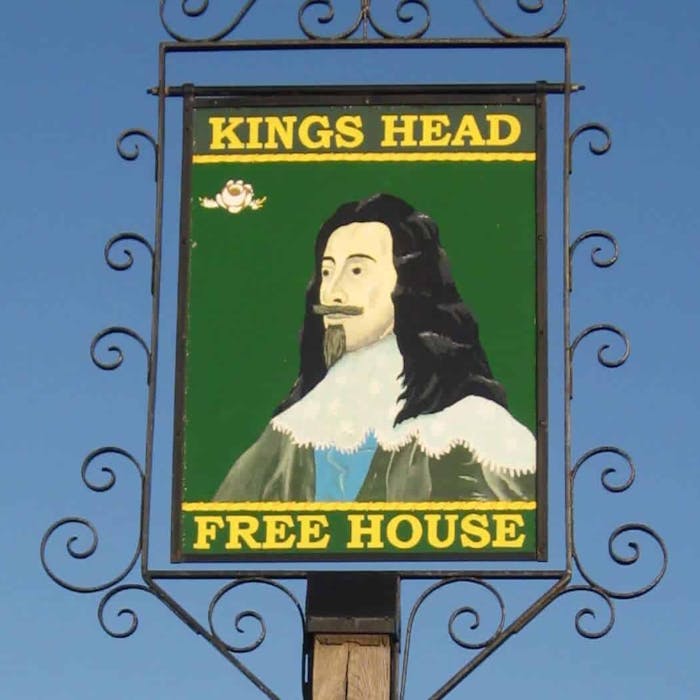
British pub signs - whispers from the past
The pub signs of Britain often go back further than the age of the buildings they adorn, and are markers of historic incidents and ancient traditions.
The idea of the pub sign came to Britain at the time of the Roman invasion. Wine bars in ancient Rome hung bunches of vine leaves outside as trading signs but when the Romans arrived in chilly Britain, they had to improvise and hung up bushes to mark out the inns. The names Bush or Bull & Bush still survive from these days.
From the Middle Ages, religious houses ran the earliest true inns to cater for pilgrims and knights on their way to the Crusades in the Holy Land. Ye Olde Trip to Jerusalem, whose cellars are carved from the rocks beneath Nottingham Castle, is an example of this sort of pub. Established in 1189, it claims the title of the oldest pub in England and was a stopover point for forces on their way to meet with Richard the Lionheart.
Other signs on this theme are the Turk’s Head, Saracen’s Head and Lamb & Flag – the lamb representing Christ and the flag the sign of the crusaders. It is said that many old pubs were started by soldiers returning from the Crusades with enough stolen booty to set themselves up as publicans. When the Crusades ended, pilgrimages had become fashionable, and hostelries were needed to cater for these long distance travellers.
With the Dissolution of the Monasteries in the 16th Century, many pubs rushed to change their names to eradicate any Catholic links. Arks became Ships and St Peter, the guardian of the gates of Heaven, became the Crossed Keys.
However, many of the landlords thought it safer to show allegiance to the monarch and hastily adopted titles like the King’s Head or the Crown. Henry VIII who ordered the Dissolution is, unsurprisingly, the most popularly depicted monarch.
Heraldry has been a recurrent theme, the Black, White, Red and Golden Lions have formed part of the royal coat of arms since the time of the Norman Conquest. The Unicorn was in the Scottish arms, the Red Dragon in the Welsh and the White Horse in the Hanoverian. The Rising Sun was the badge of Edward III. Local gentry often had pubs on their land named after them.
Anyone who caught the public imagination was likely to be immortalised such as Lord Nelson or Wellington.
One of the most affectionate tributes is reserved for the Marquis of Granby, Commander in Chief of the British army. After the Battle of Warburg, he bought pubs for all his non-commissioned officers. His generosity ruined him however and he died in 1770 leaving crushing debts of 37,000 pounds.
In the days of a largely illiterate population, pictorial signs were an essential way of advertising the inn or the type of entertainment on offer inside. Any pub called the Cock Inn or the Cock Pit would once have been a venue for cockfighting. Ye Old Fighting Cocks in St Albans (which also claims to be the oldest pub in Britain) was originally the dovecote for St Albans Abbey.
After the Dissolution, it was realised that its circular shape made it a perfect venue for cockfighting. Just to confuse things, any pub called the Cock & Bottle has nothing to do with sport. It simply denotes that both bottled and draught beers were available.
As to other entertainments, the Bear denotes bear-baiting, the Dog & Duck hunting, the Bull & Dog bull-baiting and the Bird in Hand, falconry. Nowadays, the more modern sports are represented by names like the Cricketers’ Arms, the Anglers’ Rest or the Huntsman.
Often the predominant trade of the area would give the pub its name. The Golden Fleece is a reflection of the local wool trade. The Coopers’, Bricklayers’, Saddlers’ and Masons’ Arms are commonplace signs. Legend has it that the Smiths Arms in Dorset was once a blacksmith’s forge where Charles II stopped to have his horse shod. Whilst he was waiting he demanded a beer but was told the smithy was unlicensed. Exercising his royal prerogative, he granted one and was duly served.
In the 18th Century, the population became more mobile and a need for coaching inns grew with predictable names such as Coach & Horses or Horse & Groom. Later the advent of steam gave every town its Railway Inn or Station Arms.
Further reading
Links to external websites are not maintained by Bite Sized Britain. They are provided to give users access to additional information. Bite Sized Britain is not responsible for the content of these external websites.
